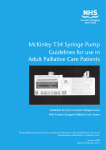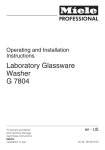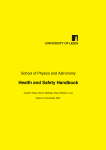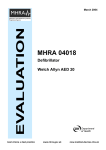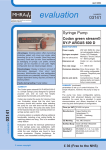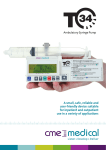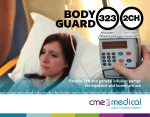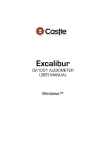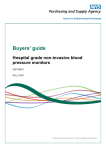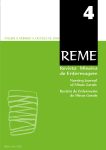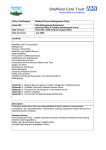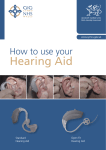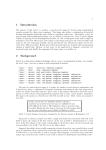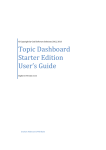Download Buyers` guide: Ambulatory syringe drivers
Transcript
Buyers’ guide Ambulatory syringe drivers CEP08046 December 2008 Contents 2 Introduction ............................................................................................. 3 Technical considerations......................................................................... 6 Operational considerations...................................................................... 9 Economic considerations ...................................................................... 11 Purchasing ............................................................................................ 14 Market review........................................................................................ 19 Acknowledgements ............................................................................... 25 Glossary................................................................................................ 26 References............................................................................................ 27 Appendix 1: Supplier contact details ..................................................... 30 Appendix 2: EU procurement procedure ............................................... 31 Appendix 3: Evaluation protocol............................................................ 34 Author and report information................................................................ 39 CEP08046: December 2008 Introduction 3 Continuous subcutaneous drug delivery Continuous subcutaneous infusion (CSI) is an alternative to intravenous (IV) or intramuscular infusion that is typically offered when the oral route for medication delivery no longer works. CSI can also be offered when IV access is difficult to achieve and when intramuscular injections are painful and distressing. Delivery of small amounts of concentrated drugs into subcutaneous tissue also provides an alternative therapy for patients unable to tolerate the large amounts of fluid associated with IV infusions. Typically, CSI is less expensive than IV infusion and is associated with a lower incidence of injection site complications [1]. Drugs given via CSI are usually rapidly absorbed and have a high bioavailability (generally 100%) [2]. CSI can be used to deliver a variety of drugs including heparin, insulin, bronchodilators, chemotherapy and cytotoxic drugs [3]. However, its main area of application is in symptom management for cancer patients and palliative care. By maintaining a stable plasma level of drugs via continuous infusion, appropriate symptom control can be achieved without the unwanted effects that can result from episodic drug administration [4]. A variety of infusion devices can, theoretically, be used for CSI. However, standard IV infusion pumps are generally too large and heavy for comfortable use by ambulatory patients. They also typically operate at a much higher range of volumes than is useful for CSI. Small and lightweight ambulatory infusion pumps are more suitable for CSI, and both electrically and mechanically powered small devices have been widely adopted [5;6]. UK practice In the UK, the Smiths Medical (formally Graseby) MS26 and MS16A syringe drivers are most commonly used to deliver continuous subcutaneous infusions [7]. In palliative care, the use of syringe drivers allows several drugs to be delivered simultaneously via a single infusion (provided the drugs are compatible). At least 29 different drugs are reported to be in use in palliative care practice in the UK, and numerous combinations are possible [8]. The most commonly used medication is diamorphine or morphine, sometimes mixed with midazolam, levomepromazine, haloperidol or cyclizine,[8], with water as the most common diluent [9]. Sodium chloride is another widely used diluent, but it can be incompatible with some drug mixtures [3]. Combinations of three or more drugs have also been reported [9]. In palliative care, the daily dose of drugs is typically prepared in 10 or 20 ml syringes, and is delivered continuously over 24 hours. The delivery rate, once set up, should remain fixed until infusion is complete, as changing it would alter the prescribed daily CEP08046: December 2008 Introduction 4 dose. Typically, a new syringe is set up by the carer every 24 hours, and the giving set changed every three or four days [4]. Smiths Medical MS16A and MS26 syringe drivers can operate with syringes of any brand or volume that can physically fit the driver. This offers greater flexibility to the user by not restricting use to a particular syringe type or volume. Syringes up to 35 ml can be used. The use of larger syringes, e.g. 50 - 60 ml, has been reported, but this is exceptional [4]. The maximum length of fluid within the syringe that can be infused is restricted to 60 mm, which is approximately equivalent to 25 ml (when using a 35 ml syringe) [10]. At present, the MS series syringe drivers are regarded as an “essential component of British palliative care” [7], and local guidelines and policies relating to palliative care therapy have been established to accommodate the features and functionality of these devices throughout the UK [8]. Around 150 000 syringe drivers were estimated to be in use globally, mainly for palliative care applications [4], with around 40 000 devices in the UK, the majority of which are used in primary care. Although the MS26 and MS16A syringe drivers have proven to be very useful tools in palliative care, they were designed before the introduction of the IEC 60601-2-24 standard [11], which was developed to ensure the safety of infusion pumps, and do not comply with it. Although labelling on the two drivers indicates the delivery rate, they appear very similar, aside from the colour. Confusing MS16A (which delivers in mm per hour) with MS26 (which delivers in mm per 24 hours) can result in an infusion rate 24 times higher than required, and numerous adverse incidents of this type have been reported [3;12;13]. A Hazard Notice issued by MDA (now MHRA) advises users to ensure that they understand the differences between the two drivers in order to minimize the risk of confusing them [12]. At present, many palliative care services adopt the use of one type of syringe driver only (typically MS26) in order to minimise this risk. Currently, there are safer alternatives to the MS26/MS16A drivers on the UK market; two of which comply with IEC 60601-2-24. Adopting safer syringe drivers would require modification of established working protocols and practices in UK palliative care, and a significant amount of re-training for staff. A clear indication of the benefits of such an approach is needed to make the case for change [14]. National guidance Australia and New Zealand have national initiatives to replace the MS series drivers, but there is no similar central initiative in the UK. The MHRA has issued general guidance on infusion devices [15], which includes recommendations on the safety features expected in infusion pumps. None of these features is offered by the CEP08046: December 2008 Introduction 5 MS26/MS16A syringe drivers. The National Patient Safety Agency (NPSA) has also published guidance on the safe administration of drugs in the NHS [16]. Scope This buyers’ guide compares all ambulatory syringe drivers currently available in the UK market, and includes the results of a usability assessment and a user survey. Technical, operational, economic and purchasing considerations are also discussed. CEP08046: December 2008 Technical considerations 6 Features of syringe drivers Ambulatory syringe drivers (also known as syringe pumps) are small, batterypowered medical infusion devices which allow continuous fluid delivery from a syringe at a programmed rate. They are designed to deliver the therapy with minimal disruption to a patient’s daily life and activities, and therefore are required to be small and lightweight. Most syringe drivers are designed to deliver infusions from any brand of syringe with a volume of 2 - 30 ml. However, some devices require the larger syringes (20 - 30 ml) to be under-filled to allow delivery. Larger volume syringes (50 - 60 ml) can be used with some ambulatory syringe drivers, but they too are usually under-filled to fit into the driver or its carry case. Ambulatory devices need to be battery-powered. An option to run on mains power is offered for some devices, but this would require connection either to a docking station or to a special charger for a device running on an integral rechargeable battery, preventing ambulatory use during this time. Drug delivery patterns and accuracy Fluid is not delivered smoothly by ambulatory syringe drivers, but as a series of small boluses. This is common for most battery-operated ambulatory pumps. Most of them have discontinuous patterns, particularly at low flow rates. This is a deliberate design to conserve battery power. Smooth and continuous delivery requires more battery power, and reduces the overall battery life. Stop-start flow patterns result in poor minute-to-minute accuracy, which is expressed as a constancy index. The constancy index of an infusion device provides a guide to the minimum half life of a drug suitable for administration. It is determined at a flow rate of 1 ml/h. The constancy index needs to be shorter than the drug’s half life. CSI, however, does not require very smooth flow patterns. The overall hourly accuracy of delivery is more important than minute-to-minute accuracy. Smooth delivery might be important for administration of some IV drugs, particularly cardiovascular drugs. Start-up time The start-up time is defined as the time required for an infusion device to start delivering at a set rate. This parameter is affected by the design of the device’s driving mechanism, and by procedures carried out prior to starting the pump. For a syringe pump, automatic purging of a syringe reduces the start-up time, as this helps to eliminate the mechanical slack in the system. Most modern syringe drivers offer the purge function as an option. The purge volume can be set up when the pump is configured, or it can be controlled by the user. Delivery options Ambulatory syringe drivers complying with IEC 60601-2-24 offer a 24-hour delivery as an option. This option allows the user to set up an infusion over 24 hours quickly CEP08046: December 2008 Technical considerations 7 and reliably, without the need to perform a flow rate calculation. The syringe recognition system registers the volume of fluid in the syringe, and the delivery rate is calculated by the device. The user only needs to check the parameters of the infusion and initiate the delivery. This is a useful feature for palliative care applications, particularly where the delivery of drugs is typically performed over a 24hour period. Other delivery options may be offered, such as setting up a different delivery rate or setting up the time of delivery. The choice of delivery options may be restricted by the manufacturer, at the purchaser’s request, to minimise the risk of user error. An additional bolus function with an option to initiate immediate delivery at maximum flow rate is offered on some pumps, but this can always be disabled during configuration if clinical practice does not advise using it. There are specific reasons for restricting bolus drug delivery in palliative care applications, including risk of increased side-effects from delivery of a higher dose of different drugs mixed in a syringe, and pain at the needle site [4]. Modern syringe drivers can be calibrated to operate with most commonly used luerlock syringes. The amount of fluid that can be delivered from large volume syringes is limited for some pumps because of the limited length of the mechanism that drives the syringe plunger. Safety All modern infusion devices are expected to have alarms to alert users to situations that could compromise therapy delivery, such as power interruption, a blocked line, a displaced syringe, tampering with the infusion, and end of infusion. Ambulatory syringe drivers complying with IEC 60601-2-24 offer all these safety features. An alarm typically involves an audible signal accompanied by a visual message on a driver’s display indicating the reason for alarm and providing instructions on how to resolve the problem. A syringe recognition system does not only alert a user that syringe displacement has occurred during delivery, but also helps to prevent delivery error from the use of an incorrect syringe. The syringe recognition system employs a series of sensors which register the position of the syringe barrel, the barrel’s flanges and the plunger, and alerts a user if displacement has occurred from any of these points. Syringe displacement can have serious consequences for a patient. When a pump is raised relative to the infusion site, high positive pressure in the line may cause the syringe to empty its contents into the patient. Siphoning can occur when a driver is lower than the infusion site (high backpressure in the system). However siphoning is considered to be a less of an issue for subcutaneous infusion than it is for intravenous infusion. CEP08046: December 2008 Technical considerations 8 The ability of the syringe recognition system to distinguish between different syringe brands is dependent on the barrel clamp sensor being able to distinguish differences in syringe barrel diameter. At present, there are no syringe drivers on the market that are able to distinguish the small differences in diameter of all syringe brands successfully, and this is particularly true of small volume syringes. For this reason the syringe recognition system is not truly “automatic” as it requires a user to confirm the pump’s best estimate. Significant flow rate errors can result from incorrect syringe confirmation. Users are given an option to configure a driver to recognise only specified syringe brands and volumes. Restricting these options can reduce the risk of programming errors in some circumstances. Protection against free flow is not typically offered by syringe drivers, but for CSI this issue is less of a concern than it is for IV infusions. Some manufacturers, however, offer extension sets incorporating an anti-siphon valve to prevent free flow. An event log stores a record of all key presses performed by a user during device operation, and this log is an invaluable source of information on the operation of the device, or any interference that might have occurred. Typically, event logs are downloadable from the pump memory to a PC for further analysis, and the software necessary for this should be provided by the manufacturer. Prevention of accidental changes to an infusion delivery can be achieved using a keypad lock or provision of a lockable box in which to house the pump. Not all syringe drivers offer a lockable box as standard; for some drivers it is an optional accessory. CEP08046: December 2008 Operational considerations A wide range of factors can contribute to the suitability of a syringe driver for a specific therapy. Table 1 highlights some of these factors for a palliative care scenario. Table 1: Operational considerations in selecting a syringe driver for palliative care Feature Description Pump appearance Pumps allowing delivery over different fixed time periods should be clearly distinguishable from each other, to minimise the risk of setting up an incorrect delivery rate. Carrying the pump For ambulatory use, the pumps should be small, lightweight and comfortable to carry around in the carry cases provided. Carry cases should be washable at 60ºC. Dosing units Infusion delivery units should be in millilitres per hour (ml/h) rather than in millimetres per hour (mm/h). This would maintain consistency in training as other infusion devices are typically set up to deliver in ml/h. Using dosing units of ml/h also facilitates drawing up solutions and monitoring the delivery using the millilitre measurement scale on the side of the syringe. Infusion devices compliant with the safety requirements for infusion pumps deliver in ml/h; the delivered volume in ml is recorded by the device, and is available to view at any time during delivery. Delivery regime The option to set up infusion over a 24-hour period is very convenient, particularly in palliative care, as drug dosage is typically prescribed over 24 hours. With an automatic syringe volume recognition system a user would only need to confirm the time of delivery as the rate is calculated by the pump. Bolus deliveries Devices offering restricted access to the bolus/prime function can prevent unauthorised delivery at the maximum flow rate. If several drugs are mixed in a syringe then a bolus delivery can affect the daily prescribed dose. The option to prevent bolus delivery should be offered in configuration. Flow rate safety limits An option to restrict the flow rate to a specific range with an upper and lower limit, or configuring the system for a single flow rate would be an added safety feature, as this would prevent the user from setting rates outside the preset safety limits. Battery function indicator Visual indication of the battery status should be provided. Visual and audible alerts to warn a user of low battery status are essential to ensure safe therapy delivery. Syringe recognition system Pumps offering a syringe recognition function require a user to confirm the volume and brand of the syringe used; this is an extra safety precaution which helps to prevent a delivery error from an incorrect syringe. Any permitted syringe brand and volume can be used; the volume of the syringe content is estimated by the pump. CEP08046: December 2008 9 Operational considerations Feature 10 Description Alarms and alerts The ability of a pump to indicate a malfunction or a dangerous condition, which can compromise the therapy, is an important safety feature. Users should check that the alarm tone is sufficiently audible. Clear messages on the device’s display to guide the user on the cause of alarm and actions for resolving the problem are helpful. Duration of standby alarm time is important: a long standby alarm time could result in delayed feedback from the pump, if infusion is not initiated immediately for any reason. Power supply Disposable batteries allow greater flexibility for ambulatory applications as they typically run for longer compared with a rechargeable battery’s single charge, do not require regular recharging, and can be purchased from most retail outlets. However, use of rechargeable batteries can reduce wastage significantly, and is more cost-effective. For integrated rechargeable batteries, management of the battery charger should be taken into account and provision made for its storage. Event logging Event logging allows the driver’s operation or any unauthorised interference with its performance to be traced by storing the history of any key presses in the driver’s memory. This could help in identifying the cause of performance issues. Photosensitive drugs Some drug mixtures may be light-sensitive and the driver should offer protection by providing a specially designed holster or syringe cover. Syringes Use of large volume syringes allows solutions to be further diluted, which can be advantageous with some drugs. Provision for using large volume syringes fully-filled should be checked, as not all drivers offer this facility. Lockable box Some clinical protocols may require drugs to be locked in the infusion devices in order to prevent tampering with syringe content. This would require the use of a lockable box during delivery. The total weight of a driver and its lockable box would need to be taken into account, and provision of carrying accessories to accommodate the lockable box should be offered. Infusion sets Sets with a narrow internal diameter and shorter lengths (also called ‘low volume’ sets) reduce the priming volume. Training and support Training and ongoing product support are available from all suppliers, and are essential when purchasing a new syringe driver. Some suppliers also offer both clinical and technical on-site training and support through dedicated teams throughout the working life of their products, at no extra cost to the customer. Most suppliers offer a flexible competency-based training programme with some suppliers’ training programmes leading to a competency-based certificate accredited by the Royal College of Nursing. CEP08046: December 2008 Economic considerations 11 Direct cost Although the list prices for the ambulatory syringe drivers are similar; when considering the drivers’ cost per warranty year, differences can be seen between devices (Table 3). Calculations of costs over a five-year period are included; for some drivers five years is a minimum estimated life-time of the device. The cost analyses are based on the list prices provided by the manufacturers for their devices and on the general usage of syringe drivers in palliative care, with only the costs of disposables and batteries included in calculations. The costs of training, servicing, discounts on bulk purchase are not considered. The annual cost of disposables is given in Table 2 and is based on a regimen of replacing a syringe every day, and a catheter and dressing every three days [3]. The cost of disposables is assumed to be the same for all the drivers. The following disposables were indicated as the most commonly used, and are included in the calculation: BD Plastipak 20 ml syringe, Graseby Flo-Safer winged infusion set, and Tegaderm transparent dressing. The total annual cost of disposables for a syringe driver in palliative care is estimated to be £570.50. Table 2: Annual cost of disposables for a syringe driver in palliative care Syringes * ( £) Catheters ** (£) Dressing *** (£) Total annual disposables cost (£) 61.90 244.60 264.00 570.50 Notes: * BD Plastipak 20 ml syringe (Ref: 300629, list price £20.34 for the box of 120 ** Graseby Flo-Safer Winged infusion set (Ref: 0105-0029, price list £2.01 each) *** Tegaderm Transparent dressing (Ref: 1624W, price list £2.17 each) The battery replacement regime varies for different drivers, and for different types of battery. This has an impact on the overall annual running cost of the driver. Using rechargeable batteries reduces wastage and offers some savings over disposable batteries. Savings of around £5,700 over a five-year period can be achieved for 30 devices running on rechargeable batteries (Table 3). For drivers running on integral rechargeable batteries, the additional cost of labour and shipping would need to be added to a battery replacement cost. Rechargeable batteries that are integrated as part of the device can only be replaced by the manufacturer or hospital servicing departments, and the batteries are only available from the manufacturer. CEP08046: December 2008 Economic considerations 12 The cost comparison, provided in Table 3 is based on the assumption that all syringe drivers are equally effective. Table 3: Running cost of an ambulatory syringe driver Pump name AD Syringe driver MPdaily / MP-101 / MPml/h* MS16A/ MS26 McKinley T34 Unit cost (£) 960 875 / 912* 852.50 995 2 2 1 2 480 438 / 456* 852.50 498 Li-Ion 1.5 V AAA 9V Duracell Procell 9V Duracell Procell 9V NiMh 170mAh 1 6 1 1 1 Warranty period (years) Pump costs per warranty year (£) Costs of batteries Battery type Number of batteries required ** Battery unit cost (£) 23.08 0.38 0.80** 0.80** 10.92 Battery cost per driver (£) 23.08 2.28 0.80 0.80 10.92 Battery life (days) 1095 70 50 7 1095 No. of battery replacements per year 0*** 6 8 53 0 Battery cost per year per driver (£) 0.00 13.68 6.40 42.40 10.92§ Battery cost over 5 years per driver (£) 23.08 68.4 32 212 21.84 Battery cost per 5 years for 30 drivers (£) 692.40 2,052 960 6,360 655.20 Running cost per 5 years for 30 drivers (£) 115,067 113,877/ 114,987* 112,110 121,785 116,080 ◊ Notes: * The list price and cost analysis are for the MPml/h driver. ** Disposable batteries: prices taken from the NHS Logistics catalogue, 2006 *** This driver uses an integrated rechargeable battery which, on average, needs to be changed once in three years. Initial cost of the battery is included into the driver’s list price § This pump uses a standard rechargeable battery. Price includes the cost of a charger and two rechargeable NiMh 170mAh batteries; this is not included into the pump’s list price. The batteries and the charger need to be changed once in three years ◊ Charger and batteries recommended to be changed once in three years by CME McKinley A typical purchasing package would include a syringe driver, a battery, a carry bag, a user manual and training material. The lockbox is provided by some manufacturers free of charge with any new purchased pump; others supply it as a cost option. Carry packs/holsters are also available as optional accessories (Table 4). Carry packs should be washable if for multiple use, or disposable for single use only. Although CEP08046: December 2008 Economic considerations 13 syringe drivers do not require the use of dedicated infusion sets, some manufacturers offer proprietary infusion sets for their products. Table 4: Syringe driver accessories price list AD syringe driver MP-101/ MPdaily/ Mp ml/h MS16A/MS26 McKinley T34 35 (washable) 32 36.30 40 (washable), 10 (disposable) Lockbox, list price, (£) 7.95* 60** 84.70 Proprietary sets, (name/product code) a) MFX 1952 b) MFX 2259*** ↨ c) MFX 1633 Proprietary sets, (list price per unit) a) £2.39 b) £1.08 c) £1.08 Accessories Carry pack, list price, (£) Immunoset † Flo Safer Winged (Ref: 0105-0029) £2.20 80 a) Ref:100172S*** b) Ref: 100170S*** (1m line) a) £1.85 b) £2.45 Notes: * Integral lockable syringe cover, available in packs of 5 ** For all Micrel devices: the lockbox is not included into the original purchasing package, but is available at the specified list price *** The prime volume of these sets is 0.3 ml. ↨ Prime volume is 0.4 ml † A lockbox is offered free of charge with a new MS driver. Additional lockboxes may be purchased. Maintenance and service Most purchasers carry out their own servicing and maintenance of syringe drivers, with EBME/MEMS departments typically servicing local community devices as well. Manufacturers typically conduct initial training programmes for clinical and technical staff at no extra charge. Further upgrade training would generally be the purchaser’s responsibility, although some manufacturers offer extra training if required, at no additional cost, over the life-time of the device. CEP08046: December 2008 Purchasing 14 There is no national consensus on the required performance specifications for syringe drivers. Hospital and community trusts generally have their own selection criteria based on local clinical needs and priorities. The replacement process is primarily driven by hospitals, but can sometimes involve community input. Community involvement is considered important as syringe drivers are used both in primary and secondary care settings, including hospices, the community, nursing homes and district nursing care. Collaboration between the community and hospitals can help to ensure staff and patients are familiar with the drivers used in both these care settings. Current market distribution Currently, there are around 40 000 MS series syringe drivers in use in the UK, and their use has been established in clinical practice for more than 20 years. However, safer syringe drivers are now available, and the market is likely to shift over time to reflect this. Selection criteria The selection criteria for a new ambulatory syringe driver are dependent on the clinical application(s). Compliance with IEC 60601-2-24 will ensure that the driver meets the key requirements for use in palliative care, as well as a variety of other applications, including oncology, paediatric, cystic fibrosis, etc, and will be capable of delivering therapies via both subcutaneous and IV routes. This application diversity supports standardisation of infusion equipment on a relatively small number of devices. The option to set up a delivery in volume units (ml/h) allows consistency in training, as other infusion devices are typically set up to deliver in the same way. A short trial of the syringe driver would normally be performed by clinicians prior to purchase. Many trusts include a technical assessment by a medical engineer or technician to assess the driver’s design and ease of replacing parts, as these also have cost and safety implications. Servicing and maintenance procedures would also be checked. Figure 1 illustrates key elements of the selection process. CEP08046: December 2008 Purchasing 15 Figure 1. Decision diagram Critical drug delivery required? Yes Consider mains powered pumps with good long and short-term accuracy, and a highly sensitive occlusion alarm. For other requirements, refer to [15], page 53 No Ambulatory delivery required? No Consider non-portable electrically powered pumps, refer to [15], page 53 Yes IV delivery required? Large volume delivery required? No Yes Consider dedicated pumps for enteral feeding No Compliance with IEC 606012-24 is required Large volume delivery required? Yes Check therapy and safety requirements Yes Consider pumps for parenteral infusions, refer to [17] No Consult CEP buyers’ guide market review tables for a suitable syringe driver Arrange trial of suitable syringe drivers Training The implementation of modern syringe drivers that offer similar operation to the MS series would not require modification to existing clinical protocols; however extra clinical and technical training in using these devices would be necessary.[17] The purchase of devices complying with IEC 60601-2-24 would require additional comprehensive training for clinical and technical staff who have previous experience CEP08046: December 2008 Purchasing 16 in dealing with syringe drivers delivering in mm/h or mm/24h. Clinical protocols for therapy provision and monitoring would need to be modified. However, infusion devices meeting the requirements of the safety standard are simpler to set up, program and monitor than devices not meeting the standard. Training programmes and on-going manufacturer’s support, tailored to user needs, are essential in facilitating the adoption of new syringe drivers. Replacement of all devices simultaneously would reduce the risk of error resulting from using different devices and different protocols at the same time. However, given the large number of older design syringe drivers in use, replacement would probably need to be phased, ideally on a ward or hospital basis, to minimise the usage of different models of device within the same clinical setting. Tendering and purchasing process Trusts often go through the tendering process for purchasing new syringe drivers or upgrading the existing stock themselves, with some involving the community trusts in this process as well. However, as staff and patients are moving through both primary and secondary care settings, it can be helpful to standardise devices on a regional basis. Regional collaboration can also facilitate the tendering process and help to maximise value for money achievable. NHS Supply Chain has indicated an intention to develop a national framework agreement for a range of infusion devices, including syringe drivers. Service and maintenance Most purchasers typically carry out their own servicing and maintenance of syringe drivers. The local community is typically served by EBME/MEMS departments of local hospitals. Purchasing procedures The Trust Operational Purchasing Procedures Manual provides details of the procurement process [18]. European Union procurement rules apply to public bodies, including the NHS. The purpose of these rules is to open up the public procurement market and ensure the free movement of goods and services within the EU. In the majority of cases, a competition is required and decisions should be based on best value. CEP08046: December 2008 Purchasing 17 The EU procurement rules apply to contracts worth more than £90,319 (from January 1st 2008) [19]. Further details of the process are detailed in Appendix 2. NHS Supply Chain (NHS SC) offers national contracts or framework agreements for some products, goods and services. Use of these agreements is not compulsory and NHS organisations may opt to follow local procedures. Sustainable procurement The UK Government launched its current strategy for sustainable development, Securing the Future [20] in March 2005. The Strategy describes four priorities to progress sustainable development, in the UK and in the world as a whole: • sustainable production and consumption – working towards achieving more with less • natural resource protection and environmental enhancement – protecting the natural resources and habitats upon which we depend • sustainable communities – creating places where people want to live and work, now and in the future • climate change and energy – confronting the greatest identified threat facing the global community. The strategy also highlights the key role of public procurement in delivering sustainability. The main sustainability issues relating to the use of ambulatory syringe drivers are concerned with the use of batteries, both disposable and rechargeable. These issues will be outlined in terms of battery generated wastage and end-of-life product disposal. Battery usage Ambulatory syringe drivers use battery energy to operate. There are devices which run on disposable batteries only, but some can use a rechargeable battery. Using rechargeable batteries significantly reduces wastage, and is more cost effective than using disposable batteries. However, this advantage would need to be carefully considered against the needs of ambulatory patients. Drivers using standard NiMH 150mAh rechargeable batteries would require two batteries, with one battery in use whilst the other is being recharged. This type of battery requires recharging every 24 hours. Rechargeable batteries are recharged using mains electricity from either a specially provided charger (for integral batteries) or from a standard charger (for standard batteries). Costs of mains energy and battery usage should be included in whole-life calculations. CEP08046: December 2008 Purchasing 18 The NiMH battery contains no toxic metals and has no special requirements for disposal. However, it is advisable to send them for recycling. Li-ion batteries have special disposal requirements and should be returned to the manufacturer for disposal. End of life disposal Consideration should be given to the likely financial and environmental costs of disposal at the end of the product’s life. Where appropriate, suppliers of equipment placed on the market after the 13th August 2005 should be able to demonstrate compliance with the UK Waste Electrical and Electronic Equipment (WEEE) regulations (2006) [21]. The WEEE regulations place responsibility for financing the cost of collection and disposal on the producer. Electrical and electronic equipment is exempt from the WEEE regulations where it is deemed to be contaminated when scheduled for disposal by the final user. However, if it is subsequently decontaminated such that it no longer poses an infection risk, it is again covered by the WEEE regulations, and there may be potential to dispose of the unit through the normal WEEE recovery channels. CEP08046: December 2008 Market review 19 Market overview Several ambulatory syringe drivers are available in the UK: • • • • Cardinal Healthcare AD syringe driver Eden Medical Micropump MPdaily / MP-101 / MPmlh syringe driver Smiths Medical (Graseby) MS26 / MS16A syringe driver CME McKinley T34 syringe pump. Smiths Medical MS26 and MS16A syringe drivers are established products and have dominated the market for over two decades. Eden Medical syringe drivers MP-101 and MPdaily offer the same functionality as MS26/16A drivers, but have extra safety features. Two other pumps, the CME McKinley Medical T34 ambulatory syringe pump and Cardinal Health AD ambulatory syringe driver, are relatively new to the market. These last two devices claim compliance with IEC 60601-2-24 (covering requirements for infusion devices) and offer all the safety features expected from a modern infusion pump. Evaluation protocol The market review is based on our findings from consultation with device users and manufacturers, including a national questionnaire-based survey of clinical staff providing palliative care in hospital, hospice and community settings for which a response rate of 61% (147/240) was achieved. In addition, we conducted in-house usability assessments, with a team of eight clinicians and trained evaluators. The clinicians comprised palliative care specialists working in both hospital and community-based settings. Participants performed predefined tasks with each device, and then completed individually a usability questionnaire. The tasks were based on a typical procedure which users would have to perform whilst using the syringe drivers for palliative care applications. Results of the user assessment survey and the usability assessment session are reproduced separately in table 5 using a five-star rating system. See appendix 3 for further details of the methodology and the questionnaires used. Survey results The respondents experience of using syringe drivers depended on the model. On average, this was 11 years for the MS26/MS16A drivers, 16 months for the Micrel MPdaily/MP-101, 14 months for theT34 pump, and 31 days for the AD syringe driver. 20 ml or 30 ml BD Plastipak syringes and Graseby Flo-Safer Winged infusion set were reported as the most commonly used disposables. Drivers were typically used on a daily basis to deliver a range of therapies for palliative care and oncology patients. 85% of users of modern syringe drivers had previous experience of using the Smiths Medical MS26 or MS16A syringe drivers. CEP08046: December 2008 Market review 20 Table 5: Market review Pump AD syringe driver Micrel MPdaily / MP-101 MS26 / MS16A McKinley T34 List Price (ex. VAT) (£) 960 875 852.5 995 Warranty period (months) 24 24 12 24 Supplier (UK) Zi Med Eden Medical Smiths Medical CME McKinley Follow up support period 5 years 12 months 5 years 5 years 2008 2003 1976 2006 Size (H x W x D), (mm) 230 x 87 x 43 165 x 40x 23 166 x 53 x 23 169 x 53 x 23 Weight with battery (g) 470 200 185 260 Not needed 290 183 188 IPX1 IPX4 IPX1 IPX1 Type of display, size (mm) Backlit LCD, 30 x 40 Backlit LCD, 20 x 30 No display Backlit LCD, 60 x 20 Power supply Battery, mains (when placed in charger cradle) Battery only Battery only Battery (mains for alternative model McKinley T34L only) Disposable, 6 x AAA Disposable , 1x 9V Alkaline Disposable (1x 9V Alkaline) and rechargeable (1x 9V, standard) picture General information Meets IEC 60601-2-24 UK launch year Lock box weight (g) Water resistance Battery options CEP08046: December 2008 Rechargeable, 1x Li-ion Market review Pump General information Battery life* (days) Recommended syringes (ml) Accepts a full 30 ml syringe 21 AD syringe driver Micrel MPdaily / MP-101 MS26 / MS16A McKinley T34 3** 70 50 7 5 - 30 5 – 50/60*** 2 – 35*** 2 – 50*** Yes No No No, takes 38 ml volume in 50 ml syringes 60ºC 30ºC 50ºC 60º C Friction drive Motor driven linear actuator, pulsed motion Motor driven linear actuator, pulsed motion Motor driven linear actuator, pulsed motion Carry case provided Carry case max washing tº RCN accredited training Pumping mechanism Delivery in ml/h offered Functions Flow rate (min – max), (ml/h) Flow rate (min – max), (mm/time) (Mp ml/h model only) 0.1 - 200 0.1 – 28.4 (for Mp ml/h) 0.1 – 1000 N/A 1 – 99 (mm/24h or mm/h) 1 – 99 (mm/24h or mm/h) N/A Min flow rate increments 0.1 ml/h 1 mm/24 h or 1mm/h 1 mm/24h or 1 mm/h 0.1 ml/h Stated flow rate accuracy +/- 2% +/- 4% +/- 5 % +/- 2% KVO rate Bolus function offered Pump priming/purging Notes: * For a typical 24 hour infusion in palliative care ** Battery needs to be recharged regularly, at least every 3 days, using a provided charger. Estimated battery life is 3 years For disposable battery *** Large volume syringes should be underfilled to allow delivery Maximum flow rate is different for different syringe sizes and 200 ml/h is achievable only for 30/35 ml syringes CEP08046: December 2008 Market review Pump 22 AD syringe driver Micrel MPdaily / MP-101 MS26 / MS16A McKinley T34 simultaneous 2 keys press Separate power key Syringe recognition system Running infusion indicator Battery power indicator Safety Volume infused indicator Keypad lock Comprehensive alarms Configurable rate limits Occlusion alarm pressure range (mmHg) 300, 600 900, 1125 938 - 3677 100 – 1500 2 60 n/a 2 Interface with computer via charger, (RS 232) via RS 232 port none via docking station Accuracy (min/max, %)* -4.9 / +7.0 - 16.3 / +8.0** -3.7 / +5.6*** -2.4 / + 2.8 13.5 21 27 1.5 31.5**** 31.5 0.5 9 / 27 Standby time (minutes) Adjustable alarm volume Testing Event log Constancy index (minutes) Start up time (minutes) Notes: * ** *** **** Minimum and maximum accuracy of all tested flow rates, including minimum available flow rate, conducted in BIME Results are for the MPml/h model performance Results are for the MS26 performance Start up time varies depending on syringe used, with 31.5 min being the worst. The other values were within the range of 1.5 min – 19 min Start up time of 9 minutes is with purge and 27 minutes without purge CEP08046: December 2008 Market review User survey results Testing Pump Occlusion alarm time (minutes) Bolus on release of occlusion at 1ml/h (ml) No of responses received 23 AD syringe driver Micrel MPdaily / MP-101 MS26 / MS16A McKinley T34 16 38 76 16 0.03 0.69 1.09 -0.04 9 37 21 80 Support from manufacturer N/A* Battery life Ease of cleaning Meeting user needs Evaluated device AD syringe driver Micrel MPdaily MS26 = acceptable = good McKinley T34 Panel assessment of usability User instruction Pump (physical design) Setting up the pump Setting up the infusion Monitoring Safety Carrying the pump Overall usability for palliative care applications = very poor = less than acceptable = very good Notes: * no information was available from the users; the products are well established with training and servicing being conducted locally. CEP08046: December 2008 Market review 24 Table 6: Market review (summary) Overall summary Pump Micrel MPdaily / MP-101 MS26 / MS16A T34 Small and lightweight, key press start and stop of infusion, limits for flow rate can be set up, low battery alarm, event log, brief instructions on the pump body, liked by users Small and lightweight, long battery run-time, good quality lock box Strengths Complies with IEC 60601-2-24, syringe recognition system, accepts fully-filled 30 ml syringes, limits for flow rate, good syringe protection by a lockable syringe cover, lockable key pad, rechargeable battery Complies with IEC 60601-2-24, syringe recognition system offered, easy menu navigation, lockable key pad, clear display, good font size, limits for flow rate, easy to maintain and repair, accepts standard rechargeable battery Rate set up in mm over time, defaults to a non-zero rate, no syringe recognition system, no syringe displacement alarm, long time for occlusion alarm response, takes 6 batteries, buttons are not intuitive to use, disagreements in provided user instructions, recommended washable temperature for carry bag is 30ºC, lock box is heavy and does not fit the provided carry bag Potential to set up wrong delivery rate due to confusion between pumps, no stop button, rate set in mm over time, rate zero can be set up without alarm, rate can be changed without stopping the pump, rudimentary alarm system, no event log, poor protection against syringe displacement, long time to alarm at occlusion, no battery power indicator, poor running infusion indicator 30-50 ml syringes should be significantly under-filled to fit the driver; reduced battery life, some 30 ml and 50 ml syringes do not fit into the lock box. Limitations Disposable battery not offered, charger is bulky and takes extra space at bedside, no restriction on purge volume, necessity to recharge at regular intervals using a dedicated charger , key labels are not obvious and may require training to become accustomed to, menu navigation is not always intuitive, can feel heavy and cumbersome to carry in the offered carry cases New to the market, offers good safety features. Runs on an integral rechargeable battery, requires an external charger. Infusion monitoring and syringe displacement protection were praised by users. Feels bulky and uncomfortable in the carry case presently offered. Good manufacturer support and training praised by users Compact, lightweight and small size driver. Users found it easy to use and set up. Similar to the MS drivers, but offer extra safety features. Setting rate in mm/h (24h), lack of syringe recognition system and syringe displacement alarm make it vulnerable to user error Compact, lightweight and small size driver. Users found it robust, easy to use and set up, however the lack of essential safety features makes it vulnerable to user error. Setting up the rate in mm/h increases risk of error Small and compact. Its safety features, logical menu and easy monitoring were liked by users, but some found it rather cumbersome and bulky. Disposable battery life was poor, requiring frequent replacement. Compact design allows easy repair and maintenance. Good manufacturer support offered. Option to use standard rechargeable battery is offered. Summary AD syringe driver CEP08046: December 2008 Acknowledgements 25 We should like to thank the following for their contribution to this buyers’ guide. Andrew Phillips, Clinical Engineer, RUH, Bath Caroline Groom, Specialist Palliative Care Nurse, RUH, Bath Allison Falder, Senior Sister, William Budd Ward, RUH, Bath Dr Karen Groves, Consultant in Palliative Medicine, West Lancs, Southport & Formby Palliative Care Services Andrew Dickman, Senior Clinical Pharmacist, Marie Curie Hospice and Liverpool Heart and Chest Hospital NHS Trust Laurence Patuzzo, Supplies Manager, South Yorkshire Ambulatory Syringe Pump Contract Stephen Keay, Medical Equipment Training Officer, Cardiff and Vale NHS Trust Jacqui Connell, Education & Development Practitioner, Plymouth Hospitals NHS Trust Stephen Duffy, Medical Equipment Training Officer, University Hospital of North Staffordshire NHS Trust Sara Springer, Clinical Adviser/Manager, Medical Equipment Library, Southampton General Hospital Alan Beddows, Oncology, Sheffield Children NHS Foundation Trust, South Yorkshire Consortium Wendy Pepper and Ruth Gretton, Dorothy House Hospice, Wiltshire Jonathan Burrill, Category Manager, NHS Supply Chain Rachel Dixon, Product Manager, AD Syringe Driver, Cardinal Health ALARIS Products Gordon Machray, Sales Director, Eden Medical Limited Linda Smith, Senior Product Manager, Infusion and Diabetes, Smiths Medical Stephen Thorpe, Managing Director, CME McKinley UK Limited CEP08046: December 2008 Glossary 26 CSI – continuous subcutaneous infusion is a method of drug delivery via injection into the fatty layer of the skin (subcutaneous layer). Constancy index – is a characteristic of the short-term accuracy (minute-to-minute accuracy) of an infusion pump, and is defined as a minimum period of time within which the flow rate is within +/-10% of its nominal rate. This parameter is specified for one flow rate only, 1 ml/h. DH – Department of Health IEC 60601-2-24:1998 Medical Electrical Equipment, Part 2 - is the standard that details particular requirements for the safety of infusion pumps and controllers. KVO - Keep Vein Open is an infusion option which is offered automatically, if configured on, at the end of infusion and continues delivery at the lower rate in order to maintain the patency of the catheter. MDA – Medical Devices Agency (now MHRA) MHRA – Medicines and Healthcare products Regulatory Agency NiMH – nickel-metal hydride, a type of a rechargeable battery NPSA – National Patient Safety Agency VTBI – volume to be infused TVI – total volume infused RCN – Royal College of Nursing CEP08046: December 2008 References 27 [1] Storey P, Hill HH, Jr., St Louis RH, Tarver EE. Subcutaneous infusions for control of cancer symptoms. J PAIN SYMPTOM MANAGE 1990 Feb;5(1):33-41. [2] Hanks G. Principles of drug use in palliative medicine. In: Doyle D, Hanks G, Cherny N, Sir Calman, editors. Oxford Textbook of Palliative Medicine. 3rd ed. 2005. p. 219. [3] Wilson V. Guidelines for use of the MS26 daily rate syringe driver in the community. Br J Community Nurs 2000 Apr;5(4):162-8. [4] Mitten T. Subcutaneous drug infusions: a review of problems and solutions. Int J Palliat Nurs 2001 Feb;7(2):75-85. [5] Bruera E. Ambulatory infusion devices in the continuing care of patients with advanced diseases. J PAIN SYMPTOM MANAGE 1990 Oct;5(5):287-96. [6] Herndon CM, Fike DS. Continuous subcutaneous infusion practices of United States hospices. J PAIN SYMPTOM MANAGE 2001 Dec;22(6):1027-34. [7] Graham F, Clark D. The syringe driver and the subcutaneous route in palliative care: The inventor, the history and the implications. J PAIN SYMPTOM MANAGE 2005;29(1):32-40. [8] O'Doherty CA, Hall EJ, Schofield L, Zeppetella G. Drugs and syringe drivers: a survey of adult specialist palliative care practice in the United Kingdom and Eire. Palliat Med 2001 Mar;15(2):149-54. [9] Wilcock A, Jacob JK, Charlesworth S, Harris E, Gibbs M, Allsop H. Drugs given by a syringe driver: a prospective multicentre survey of palliative care services in the UK. Palliat Med 2006 Oct;20(7):661-4. [10] Dickman A. Devices for continuous subcutaneous infusions. Hospital Pharmacy Europe 2007 Dec;11/12/2007. [11] Medical electrical equipment - Part 2: Particular requirements for the safety of infusion pumps and controllers. 1998. Report No.: IEC 60601-2-24. [12] MDA Hazard: Graseby Medical MS16, MS16A, MS26 ambulatory syringe pumps. Medical Devices Agency; 1995. Report No.: 9506. [13] Poor design, poor labeling, lack of training and poor communication - Case study 1 - Graseby Pump. Patient Safety Matters 2006Available from: URL: http://www.health.qld.gov.au/patientsafety/documents/psmseptoct2006.pdf CEP08046: December 2008 References 28 [14] Shaw S, Meek F. Thinking about nursing practice and culture: syringe drivers. Int J Palliat Nurs 2007 Oct;13(10):490-3. [15] MDA DB2003 (02). Infusion systems. 2003. [16] National Patient Safety Agency. Safety in doses: medication safety incidents in the NHS (fourth report from the Patient Safety Observatory). 2007. Ref Type: Generic [17] Davey C, Skryabina E, Chan J, et al. Buyers' Guide: Portable pumps for home parenteral nutrition. Bath Institute Medical Engineering: CEP NHS PASA; 2008 May. Report No.: 08021. [18] Purchasing and Supply Agency (PASA): Trust Operational Purchasing Procedures Manual (NHS intranet only). Website 2008Available from: URL: http://nww.pasa.nhs.uk/PASAWeb/Guidance/TOPPM/LandingPage.htm [19] Office of Government Commerce EU Procurement Thresholds. Website 2008Available from: URL: http://www.ogc.gov.uk/procurement_policy_and_application_of_eu_rules_eu_pr ocurement_thresholds_.asp [20] UK Government Strategy for Sustainable Development; Securing the Future. Website 2008Available from: URL: http://www.sustainabledevelopment.gov.uk/publications/uk-strategy/index.htm [21] EC Directive on Waste Electrical and Electronic Equipment. Website 2008Available from: URL: http://www.berr.gov.uk/files/file35992.pdf [22] Purchasing and Supply Agency (PASA): Leasing. Website 2008Available from: URL: http://www.pasa.nhs.uk/pasaweb/productsandservices/leasing [23] Office of Government Commerce EU Procurement Thresholds. Website 2008Available from: URL: http://www.ogc.gov.uk/procurement_policy_and_application_of_eu_rules_eu_pr ocurement_thresholds_.asp [24] Office of Government Commerce. Website 2008Available from: URL: http://www.ogc.gov.uk/stdtoolkit/reference/documentation/p13_buscase.html [25] Purchasing and Supply Agency (PASA): Operational Purchasing Procedures Manual (NHS intranet only). Website 2008Available from: URL: http://nww.pasa.nhs.uk/PASAWeb/Guidance/OPPM/LandingPage.htm [26] Department of Health. European Union Tendering Timetable. Website 2008Available from: URL: CEP08046: December 2008 References 29 http://www.dh.gov.uk/en/Publicationsandstatistics/Publications/PublicationsProc urement/DH_4070620 [27] Purchasing and Supply Agency (PASA): Trust Operational Purchasing Procedures Manual (NHS intranet only). Website 2008Available from: URL: http://nww.pasa.nhs.uk/PASAWeb/Guidance/TOPPM/LandingPage.htm [28] Department of Health. Desk guide to procurement. Website 2005Available from: URL: http://www.dh.gov.uk/en/Publicationsandstatistics/Publications/PublicationsProc urement/DH_4109316 CEP08046: December 2008 Appendix 1: Supplier contact details ZiMed Ltd Unit 34, Llys Edmund Prys. St Asaph Business Park, St Asaph Denbighshire LL17 OJA 01745 585770 www.zi-medical.com Eden Medical Limited 1 Dryden Loan Bilston Glen Industrial Estate, Loanhead Midlothian, EH20 9HR 0131 4406500 www.edenmedical.co.uk Smiths Medical International Limited Colonial Way, Watford Herts, WD24 4LG 01923 246434 www.smiths-medical.com/uk CME McKinley UK Limited Kincraig Business Park Kincraig Road Blackpool Lancashire, FY2 0PJ 01253 894646 www.mckinleymed.co.uk CEP08046: December 2008 30 Appendix 2: EU procurement procedure 31 EU procurement procedure Lease options National frameworks are in place for operating leases to help the NHS procure leases more cost efficiently and effectively. The framework came into place on 1st April 2007 and runs for two years. Further details are available from the PASA website [22]. EU procedures The Public Sector Directive (2004/18/EC) has been transposed into UK law. This has been achieved by means of the following statutory instruments: • the Public Contracts Regulations SI 2006 No.5 (the regulations) • the Utilities Contracts Regulations SI 2006 No. 6 (not relevant to this guide). The regulations apply to contracts worth more than £90,319 (from January 1st 2008) [23] over their whole life, and specify the procedures to be followed for public sector contracting, including adherence to strict timetables, requirements for advertising, invitation to tender, and the award of contract. Organisations undertaking a procurement exercise covered by the regulations must give all suppliers an equal opportunity to express an interest in tendering for the contract by placing a contract notice in the Official Journal of the European Union (OJEU). At all stages of the procurement process, the purchaser must be demonstrably fair, as any decision made can be challenged by the unsuccessful suppliers. Establishing a procurement strategy To achieve a successful outcome, decisions need to be made on: • • • • • • • • whether an existing contract/agreement can be used the need to consider sustainable development issues whether EU directives apply the type and form of contract sourcing potential suppliers duration of contract and opportunity to review/extend payment schedules how to minimise any risks with the chosen strategy, including supplier appraisal and evaluation/clarification of suppliers’ bids. CEP08046: December 2008 Appendix 2: EU procurement procedure 32 Preparing a business case A business case should be drafted and approved before conducting any procurement exercise. Further guidance on preparing business cases is available from the Office of Government Commerce [24] and an illustrative example is provided in the NHS PASA Operational Purchasing Procedures Manual, Procedure 1-01 [25]. The EU tendering exercise EU procurements usually take between 4 and 6 months to complete. This needs to be taken into account in the planning stages. The length of the exercise depends on the chosen procedure (open or restricted). Further information is available from the DH [26]. The procurement panel A multidisciplinary team should be selected to guide the purchase. Representatives from clinical, user, technical, estates, and financial areas should be considered. Identifying potential suppliers Criteria for supplier selection must be established. A supplier pre-qualification questionnaire may be employed as an initial screen to exclude unsuitable suppliers. The questionnaire should ask for details such as skills and experience of the service engineers. Evaluation criteria Performance specifications should be derived from local operational requirements, and agreed by the procurement panel. They will form the basis for assessing the adequacy of suppliers’ technical specifications, provided in response to the technical specification questionnaire. It is important to have agreed on the performance specifications of the product as they will be used in the adjudication against company specifications. Requests for features which are supplier-specific are not permitted under the regulations. Very specific features which are not supported by operational requirements are also not allowed. Award of contract Following award of the contract to the successful supplier; unsuccessful suppliers may need to be debriefed. This is at the supplier’s request. CEP08046: December 2008 Appendix 2: EU procurement procedure Buyers must be aware of the ‘Alcatel’ procedure (see the Trust Operational Purchasing Procedures Manual [27], Procedure No.T-08, section 6 - ‘Mandatory Standstill Period’). For more information on procurement please refer to the Department of Health Website [28]. CEP08046: December 2008 33 Appendix 3: Evaluation protocol 34 Evaluation protocol To evaluate the syringe drivers/pumps, a survey of current users of these devices was conducted. A user questionnaire was specially designed for this purpose (see next page for an example). Around 25 centres across the UK that have experience in using the syringe drivers in palliative care or oncology participated in this survey. Usability assessment was conducted by eight participants comprising clinicians and trained evaluators in one three-hour session. Participants performed predefined tasks with each pump, and then completed the usability questionnaire. The tasks for different pumps were designed slightly differently to reflect the functionality of each device. Analysis Responses from the pumps’ current users were analysed and compared by using the median of the data. Results for some parameters are reproduced in the Market review under the title ‘User survey results’ using a five-point star rating. The total usability score for each device was obtained via a mutual agreement among all the participants of the usability session, and was originally based on the median of the scores given independently by each participant for each device. The results are reproduced in the Market review under ‘Panel assessment of usability, using a five-star rating system. The task list and usability questionnaire for the AD syringe driver is reproduced below. CEP08046: December 2008 Appendix 3: Evaluation protocol 35 Ambulatory syringe drivers user questionnaire General Information Please specify the pump, from the given list, you are providing this feedback for. (This form can be used for one pump brand only. Tick one box only and circle the pump(s) you have used for that brand. Please, use another separate questionnaire form if you would like to provide a feedback for any other brand). CME McKinley (T34) Micrel (Micropump MPmlh or MP101 or MPdaily) Graseby (MS 26 or MS 16A) Cardinal (Alaris AD syringe driver) 1. Are you using this pump on a trial basis? No 2. How long have you used it? Years 3. Your clinical specialty? 4. How frequently do you use this pump in an average week? 5. What type of syringe do you use? (volume, brand): 6. What type of syringe extension set do you use?(type, brand): 7. What therapy do you typically deliver with this pump? Yes Months Drug type___________________________________ Dose ___________________________________ Total therapy duration (hours) ___________________ Pump Manufacturer Tuition by a previously trained colleague Tuition by a Trust-based trainer Other (please specify) 9. Have you experienced any problems with this pump? (If so, please explain the problems) 8. Who gave you training to use the pump? 10. Who resolved the problem(s)? (please, add details if multiple problems have been resolved by different parties) Solved yourself Hospital Pump manufacturer/distributor Other (please specify) Unresolved 11. Do you have experience in using any other ambulatory pumps? ones?) No Yes (If so, which 12. General comments (please add any extra information that you feel is relevant – include an extra sheet of paper if required) P.T.O CEP08046: December 2008 13. Operating manual / instructions 14. Training received 15. Pump: Size Weight Delivery accuracy Reliability Noise level Robustness 16. Battery life 17. Setting the pump: Ease of syringe loading Priming the line Programming the rate Programming the VTBI Understanding the control panel Pressing the keys Reading information from display 18. Monitoring: Running indicator clarity Display of flow rate Display of infused volume Alarm tone 19. Pump use: Alarm appropriateness Ease of moving around with the pump for a patient Safeguards against syringe displacement Safeguards against tampering Prevention of overdoses Ease of cleaning Ease of charging battery Ease of changing battery Available carrying accessories Overall 20. How well does the pump meet your patients’ needs? 21. Are there any features you would like to see added to this pump? CEP08046: December 2008 Not applicable Very good Good Acceptable Less than acceptable Think about the syringe pump you are giving this feedback for. For each question, tick the box that best indicates your opinion. 36 Very poor Appendix 3: Evaluation protocol Comments (use an extra sheet of paper, if needed) Appendix 3: Evaluation protocol 37 Evaluated function SETTING UP THE DRIVER Draw 17 ml of fluid into the 20 ml syringe, attach the set and prime it to leave 14 ml of fluid. Attach the syringe to the driver, put on the large cover and lock the cover. Very poor Task list Very good Task list and usability questionnaire for the AD syringe driver 1 2 3 4 5 1 2 3 4 5 Ease of filling a syringe with a required volume Ease of measuring the required volume of fluid Ease of achieving the required volume after priming Ease of attaching a syringe to the driver Ease of securing the syringe Quality of the syringe holding mechanism Prevention of syringe displacing Ease of powering ON (button pressing, logic) Ease of battery charging Ease of checking the remaining battery power Switch the driver on. Reset the total volume infused and confirm the syringe (20 ml BD). Purge 0.2 ml using the Ease of purging driver. Ease of controlling purged volume Any comments related to setting up the driver: SETTING UP THE INFUSION Select the 24 h infusion option, check the volume to be infused, the rate and time of infusion. Start the infusion. Understanding the control panel Ease of pressing the keys Ease of reading the display Ease of confirming the parameters of infusion Ease of starting the infusion Ease of navigating the menu Ease of stopping the infusion Ease of powering the driver off Ease of reloading the syringe Ease of setting up a new infusion Stop the infusion, switch the driver off and reload the syringe for a new 24 hour infusion. Start a new infusion. Any comments related to setting up the infusion: QUALITY OF THE USER INSTRUCTIONS Any comments related to quality of the user instructions: P.T.O. CEP08046: December 2008 Appendix 3: Evaluation protocol SAFETY (MONITORING) Record the infusion rate, volume left in the syringe and time until the end of infusion. Rate: Remaining volume: Remaining time: 38 1 2 3 4 5 1 2 3 4 5 1 2 3 4 5 Ease of reading the flow rate Ease of identifying syringe brand and size Ease of verifying/confirming amount in syringe Display of the infused volume is: Display of the remaining volume to be infused is: Display of the time left until the end of infusion is: Clarity of the running infusion indicator Clarity of the battery capacity indicator Safeguard against syringe displacement Safeguard against tampering Prevention of overdoses (e.g. limits on flow rate) Quality of the alarm tone/alarm messages Ease of rectifying infusion after alarm While infusing, try to displace the syringe from its position. Note any messages given by the driver. If the infusion stopped, rectify the situation and continue infusion. Any comments related to monitoring and safety issues: CARRYING THE PUMP Lock the syringe cover, put the running driver into the carry bag provided and carry it around for a few minutes. Driver size Driver weight Ease of moving around with the driver Ease of putting the driver into the carry bag Ease of carrying the driver in the carry bag Ease of monitoring infusion from the carry bag Discreetness of the driver Comfort of using the carry bag Quality of the carry bag Ease of removing the driver from the carry bag Remove the driver from the carry bag. Any comments related to carrying the pump: OVERALL EVALUATION Pump physical design (e.g. weight, size, appearance, ease of handling) Setting up the pump (e.g. battery charging, powering On/Off, syringe loading, purging) Setting up the infusion (e.g. programming rate, buttons pressing, control panel navigation) Monitoring infusion (e.g. flow rate, volume infused, remaining volume/time, battery capacity) Safety (e.g. clarity of running infusion/battery capacity, syringe displacement prevention, lock box, key pad lock, alarm tone/messages, safeguards against tampering, prevention of overdoses) Carrying the pump (e.g. comfort, accessories quality, discreetness) User instructions (e.g. quality of user instructions, content/index page, diagrams, warnings) OVERALL USABILITY SCORE Overall comments: CEP08046: December 2008 Author and report information Buyers’ guide: Ambulatory syringe drivers Sign up to our email alert service Elena Skryabina, Jennifer Chan All our publications since 2002 are available in full colour to download from our website. To sign up to our email alert service and receive new publications straight to your mailbox contact: Bath Institute of Medical Engineering The Wolfson Centre Royal United Hospital Bath BA1 3NG Tel: 01225 824103 Email: [email protected] www.bime.org.uk About CEP The Centre for Evidence-based Purchasing (CEP) is part of the Policy and Innovation Directorate of the NHS Purchasing and Supply Agency. We underpin purchasing decisions by providing objective evidence to support the uptake of useful, safe and innovative products and related procedures in health and social care. We are here to help you make informed purchasing decisions by gathering evidence globally to support the use of innovative technologies, assess value and cost effectiveness of products, and develop nationally agreed protocols. CEP08046: December 2008 39 Centre for Evidence-based Purchasing Room 152C Skipton House 80 London Road SE1 6HL Tel: 020 7972 6080 Fax: 020 7975 5795 Email: [email protected] www.pasa.nhs.uk/cep © Crown Copyright 2008








































